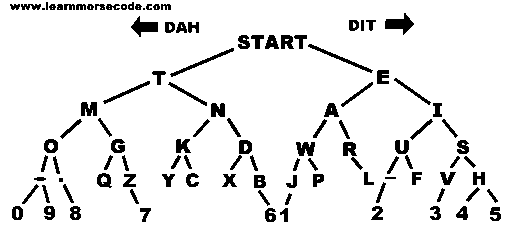Difference between revisions of "Project:Morse Code Training"
(→What is Morse: blah blah sucks. better summary.) |
|||
| Line 2: | Line 2: | ||
== What is Morse == | == What is Morse == | ||
| − | + | Morse code is a binary method of transmitting text information as a series of on-off tones, lights, or clicks that can be directly understood by a trained listener or observer without special equipment. | |
| + | |||
| + | Basic Morse Code encodes the 26 letter latin alphabet, some extra Latin letters, the Arabic numerals and a small set of punctuation and procedural signals as standardized sequences of short and long signals called "dots" and "dashes" or "dits" and "dahs". Because many non-English natural languages use more than the 26 Roman letters, extensions to the Morse alphabet exist for those languages. | ||
| + | |||
| + | (Summary adapted from the [http://en.wikipedia.org/wiki/Morse_code Morse wikipedia entry]) | ||
== Why do we need morse == | == Why do we need morse == | ||
Revision as of 12:16, 17 March 2015
What is Morse
Morse code is a binary method of transmitting text information as a series of on-off tones, lights, or clicks that can be directly understood by a trained listener or observer without special equipment.
Basic Morse Code encodes the 26 letter latin alphabet, some extra Latin letters, the Arabic numerals and a small set of punctuation and procedural signals as standardized sequences of short and long signals called "dots" and "dashes" or "dits" and "dahs". Because many non-English natural languages use more than the 26 Roman letters, extensions to the Morse alphabet exist for those languages.
(Summary adapted from the Morse wikipedia entry)
Why do we need morse
It's part of the test that Amateur Radio people need to do.
Who know Morse
Matt P ?
Who can run a workshop
To be decided
Cheat Sheet
While listening to morse code. Move down and to the right every time you hear a DIT (a dot). Move down and to the left every time you hear a DAH (a dash). The key to learning the code is hearing it and comprehending it while you hear it. The only way to get there is to practice 10 minutes a day.
Listen to code while tracing out this chart and you will find yourself writing down the letters in no time at all without the aid of the chart. The chart brings repetition together with recognition, which you don't get from any other type of code practice aid.
External links
- Just Learn Morse Code PC program
- Wikipedia on Morse code, especially section Learning methods
- Learn Morse code Learn Morse code in one minute
